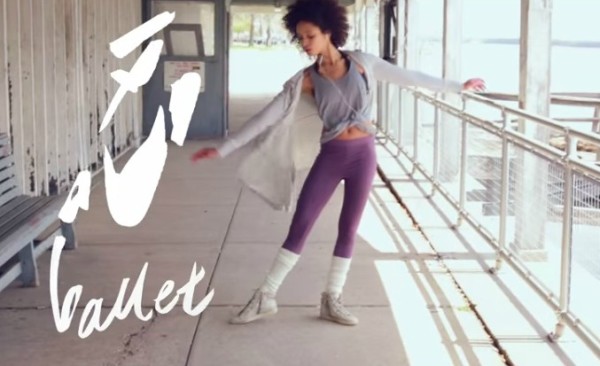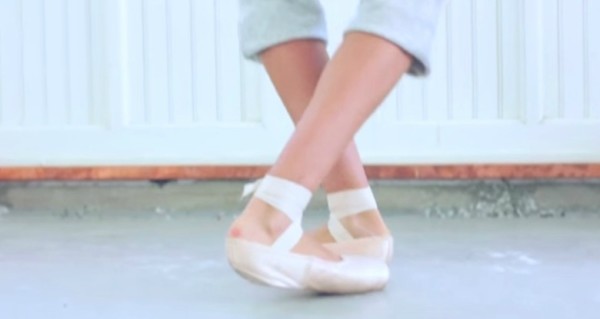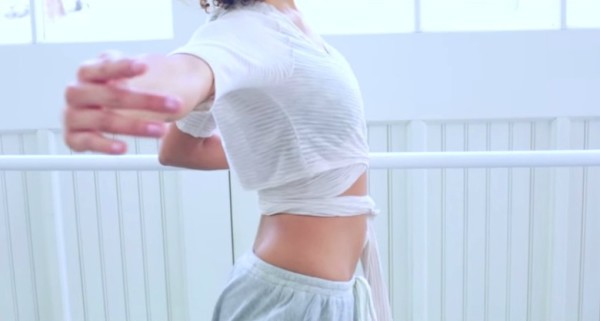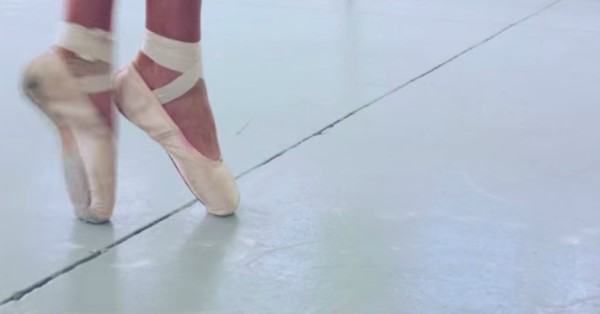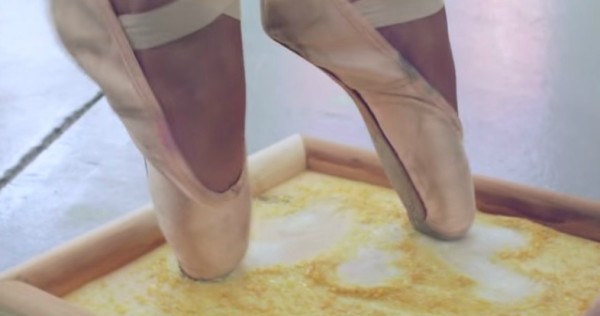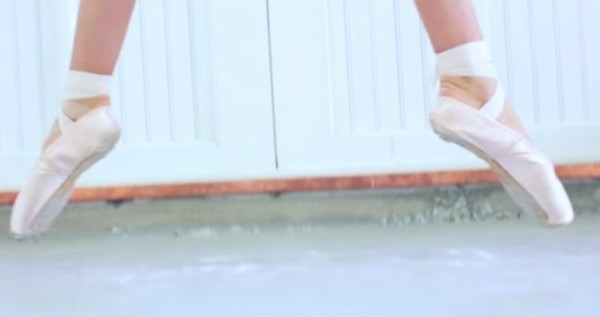![If This “Ballet” Commercial Doesn’t Upset You, Then I Don’t Know What Will! [Video]](../../wp-content/uploads/2014/05/free-people-clothing-their-idea-of-ballet-what-moves-you-featured-300-x-149.jpg)
by Romy Macias, Senior Editor | May 21, 2014 | Ballet Media, Editor's Choice
If This “Ballet” Commercial Doesn’t Upset You, Then I Don’t Know What Will! Before you jump to watch the video below, read the short text below and picture in your mind what the person saying this would look like: “I don’t even think about it at this point. I just express myself and I let myself go. I don’t think about what I’m gonna do, I just do it. I’ve been dancing since I was three. My mother put me into it. And ever since I’ve loved it. It’s so useful, because now I understand my body, I understand how it moves and I also know how to express myself in a manner that people can see. It definitely gave me discipline. You learn to take direction, especially for ballet because it’s so structural. But, eventually you just get comfortable with something. The more you feel it, the more it transcends and the more you see it in a performance. It’s not just about yourself, it’s about the people you’re dancing with or the audience you’re connecting to. No matter how good the person is, if you connect with someone while you’re looking at them, it’s because they’re showing their emotions when they’re dancing. They’re not just dancing. You have to feel it, you have to want to do it. That’s why it’s a passion for me, because I really want to do it, It inspires me to move. I can’t imagine my life without it.” Free People Clothing came out with a commercial advertising their dancing line. Now watch the video below and see what YOU think and...
![Zena Rommett Leaves Legacy Behind: Floor-Barre® Technique for Dancers and Non-Dancers! [Video]](../../wp-content/uploads/2014/04/zena-rommett-with-mercedes-ellington-2-300-x-151.jpg)
by Romy Macias, Senior Editor | Apr 17, 2014 | Ballet Health, Editor's Choice
Zena Rommett leaves legacy behind for scores of dancers, athletes, actors and “regular” folks who found a balanced exercise program. Zena Rommett (1920-2010) Video source: YouTube. Born in Italy, Ms. Rommet came to the United States at the age of 5. Zena Rommett was the originator of the world renowned Zena Rommett Floor-Barre Technique®. The technique utilizes the floor to correct and refine body alignment, and includes gentle exercises to strengthen joints, increase vitality, and help rehabilitate injuries without the pressure of gravity. Among the countless Floor-Barre enthusiasts are performers Tommy Tune, Judith Jamison, Lar Lubovitch, Melissa Hayden and John Curry who proclaim they ‘owe it all to her genius’ for saving and extending their careers while she coached them to a new level of perfection, freedom and confidence. For more on this visionary teacher, visit: http://www.stepsnyc.com/faculty/bio/Zena-Rommett/ Zena Rommett Leaves Legacy Behind Unlike traditional ballet barre exercises, which require students to stand upright holding a barre attached to a wall, Ms. Rommett’s Floor-Barre begins with students stretched on the floor and proceeds with gentle exercises to refine bodily placement, strengthen joints, increase vitality and help rehabilitate injuries without the pressure of gravity or the tendency toward rigidity that sometimes accompanies traditional standing-barre exercises. As she said in a 2008 interview in Dance magazine, “Many dancers don’t know how to stand correctly.” Source: The New York Times. Student: I don’t know if I’ve ever met a teacher like Zena, who cares as much about what she’s teaching. She’s focused on her work and carrying it through. She is a teacher’s teacher. The more you take her classes, the easier dancing...
![Ballerina Considered “Sickly” Looking Overcomes All Odds [Video]](../../wp-content/uploads/2014/04/enrico-cecchetti-teaching-anna-pavlova-circa-1920.gif)
by Romy Macias, Senior Editor | Apr 11, 2014 | Ballet Dancers, Editor's Choice
Considered “Sickly” Looking, Anna Pavlova Trained Hard To Become an Accomplished Ballerina Anna Pavlova’s early training years were difficult as she had several obstacles to overcome. Watch the video below to find out what they were and who was her most influential teacher. Video from Romy Macias’ channel on YouTube. Classical ballet did not come easily to her. Her severely arched feet, thin ankles, and long limbs clashed with the small and compact body in favour for the ballerina at the time. Her fellow students taunted her with such nicknames as The broom and La petite sauvage (The little savage). Undeterred, Pavlova trained to improve her technique. She would practice and practice after learning a step. Quote from Anna Pavlova at wikipedia.org. Considered “Sickly” Looking, Anna Pavlova Trained Hard To Become an Accomplished Ballerina I hope you’ve enjoyed learning these interesting facts about the young ballerina, Anna Pavlova. Stay tuned for the next video on Anna Pavlova’s...
![She Wasn’t The Typical Ballet Dancer. First Rejected From Famous Ballet School… But Later, Audiences Loved Her! [Video]](../../wp-content/uploads/2014/03/anna-pavlova-1891-10-years-old.jpg)
by Romy Macias, Senior Editor | Apr 2, 2014 | Ballet Dancers, Editor's Choice
Anna Pavlova: Early Years Anna Pavlova was born on January 31, 1881 in Ligovo, a suburb of St. Petersburg. to unwed parents. Her mother, Lyubov Feodorovna was a washerwoman. Some believe that her biological father was a banker named Lazar Polyakov of Jewish Russian descent. Anna’s mother later married Matvey Pavlova who adopted her at three. That is how she became Anna Pavlova. Anna fell in love with ballet as a young girl when her mother took her to see The Sleeping Beauty at the Imperial Mariinsky Theater. The Sleeping Beauty was choreographed by the great ballet master Marius Petipa. Pavlova She made classical ballet popular around the world. She traveled all 7 continents and danced in many countries. Most of the ballerinas of the time were compact and muscular. Anna was dainty and frail looking but could move audiences with her beautiful dancing. Anna was so impressed with the ballet that she asked her mother to take her to audition for the famous Imperial Ballet School. The lavish spectacle made an impression on Pavlova. At the age of nine, her mother took her to audition for the renowned Imperial Ballet School. Because of her youth, and what was considered her “sickly” appearance, she was not chosen. In 1891, she was finally accepted at the age of 10. She appeared for the first time on stage in Marius Petipa’s Un conte de fées (A Fairy Tale), which the ballet master staged for the students of the school. Source: Anna Pavlova, wikipedia.org. Anna Pavlova: Early Years Video on Romy Macias’ Channel on YouTube. Here’s Pyotr Ilyich Tchaikovsky‘s Rose Adagio from...
![Sarah Jessica Parker Takes Us Behind The Scenes of New York City Ballet Part 2 [Videos]](../../wp-content/uploads/2014/03/city-ballet-series-aol-9.jpg)
by Romy Macias, Senior Editor | Mar 19, 2014 | Ballet Companies, Editor's Choice
This second episode “Apprentices” follows several apprentices of the New York City Ballet during a year. Who will get a contract to dance with the famed company and who will not? You’ll also journey with Sarah Jessica Parker takes you through all the company ranks: Corps de ballet, soloists and principals. Sarah Jessica Parker Takes Us Behind The Scenes of New York City Ballet Part 2 Apprentices Every NYC Ballet dancer must pass through the ranks to reach the top. Silas and Claire are two apprentices standing at the gateway to a potential career with the NYC Ballet. After graduating from the School of American Ballet (SAB), some dancers are chosen to be apprentices. After a year, traditionally, on the last day of Summer season in Saratoga Springs, the apprentices find out if they will be invited to join the corps de ballet of the New York City Ballet. – Sarah Jessica Parker They all started when they were babies, three, four, five years old. They came to New York to study at SAB for the sole purpose of entering the New York City Ballet. And when you become an apprentice that’s already hope. -Peter Martins, Ballet Master in Chief AOL Originals on YouTube. Corps de ballet If and when you are offered a corps de ballet contract, “the hard work begins.” Corps members do the most dancing, and get the least amount of time off. Video courtesy of AOL Originals. Soloists Some dancers feel that the soloist rank is the hardest level of their career. Waiting for the seniority to claim certain roles means much less dancing than...
![Photographer Jesus Chapa-Malacara’s Breakthrough Images [Slide Show]](../../wp-content/uploads/2014/01/jesus-chapa-malacara-slideshow-jenna.jpg)
by Romy Macias, Senior Editor | Jan 27, 2014 | Ballet Photography, Editor's Choice, Video Interviews
[rev_slider Jesus] “Bewitching, ghostly, entrancing, and heavenly,” describe Jesus Chapa-Malacara’s photography. – Huffington Post “Here’s the thing about being a dancer. Whereas most people think of dance primarily as the cool tricks and poses, dancers spend a lot more time thinking about the movement in between than the actual poses. So I kept thinking, how can I tell that story? “ “Each photo you see is every little piece of what it takes to start and finish a ‘word’ within the ballet language, all the little details dancers spend years perfecting. So over the long term, I hope to create a visual compendium of the ballet lexicon.” – Jesus Chapa-Malacara Chapa-Malacara is a Brooklyn and Boston-based multi-media artist, photographer/director and former pro ballet dancer. A student of art , he studied photography under David Hilliard and Todd Papageorge as an undergraduate at Yale, where he earned a BA in Political Science. “In art, my passion lies in storytelling and exploring ‘the how,’ be it physically, conceptually or politically. I strive for photography that is intentional and thoughtful, that explores technical aspects–light, composition, post-production–as much as it examines the particularities of its subjects. I love what I do and deeply believe in the power of art to inspire and communicate.” Currently, I’m working on the ground-breaking series Dance Prints, including the visual ballet compendium Esprit de Corps. You can check it out on the kickstarter campaign page.” – JCM In addition to pursuing commercial photography, Jesus is working on a photographic novel, a multi-media satirical pop-art website, and a few series of self-portraits that explore physical perception. Jesus’ work has been featured in solo and...
![If This “Ballet” Commercial Doesn’t Upset You, Then I Don’t Know What Will! [Video]](../../wp-content/uploads/2014/05/free-people-clothing-their-idea-of-ballet-what-moves-you-featured-300-x-149.jpg)
![If This “Ballet” Commercial Doesn’t Upset You, Then I Don’t Know What Will! [Video]](../../wp-content/uploads/2014/05/free-people-clothing-their-idea-of-ballet-what-moves-you-featured-300-x-149.jpg)
![Zena Rommett Leaves Legacy Behind: Floor-Barre® Technique for Dancers and Non-Dancers! [Video]](../../wp-content/uploads/2014/04/zena-rommett-with-mercedes-ellington-2-300-x-151.jpg)
![Ballerina Considered “Sickly” Looking Overcomes All Odds [Video]](../../wp-content/uploads/2014/04/enrico-cecchetti-teaching-anna-pavlova-circa-1920.gif)
![She Wasn’t The Typical Ballet Dancer. First Rejected From Famous Ballet School… But Later, Audiences Loved Her! [Video]](../../wp-content/uploads/2014/03/anna-pavlova-1891-10-years-old.jpg)
![Sarah Jessica Parker Takes Us Behind The Scenes of New York City Ballet Part 2 [Videos]](../../wp-content/uploads/2014/03/city-ballet-series-aol-9.jpg)
![Photographer Jesus Chapa-Malacara’s Breakthrough Images [Slide Show]](../../wp-content/uploads/2014/01/jesus-chapa-malacara-slideshow-jenna.jpg)

